“Prossalendi’s Britannia” – Historical Perspective
Curated by Dr Megakles Rogakos
Ionian Academy, Corfu, 7 – 29 July 2018 – Eventbrite
CORFU.- As it is well known, George IV, when he was Prince Regent of the United Kingdom, founded the Order of St Michael and St George in Corfu and in Malta on 28 April 1818, two hundred years ago. This forms part of Corfu’s history and belongs to its heritage. To celebrate the Order’s bicentenary, the Corfu Heritage Foundation is organising the Corfu Festival 2018, which is to include a series of cultural events encompassing literature, music, visual arts and sports.
This Festival is taking place under the auspices of the British Embassy, Athens, the Hellenic Republic’s Ministries of Culture and Tourism and the Municipality of Corfu, between 7 July and 30 September 2018.
Three portraits of the first British High Commissioners of the Ionian Islands were created by Corfiot sculptor Paolo Prossalendi (1784-1837) and are kept in the Palace of St Michael and St George in Corfu. In addition, his Britannia sculptural ensemble crowned the façade of the Palace in the period 1823-1864. On 2 June 1864, right at the beginning of the Ionian Islands’ union with Greece, there is evidence that this sculpture was boarded on a ship to Malta, and its unknown whereabouts likely suggests that is was destroyed in Malta’s bombing in the Second World War. Therefore, the title of the exhibition “Prossalendi’s Britannia” has been carefully chosen to refer to both the Greek sculptor and the British source of his inspiration. Particular weight is given to the personification of Britannia, a Romano-Celtic goddess usually depicted with helmet, shield and trident, like Athena Pallas. The figure appeared in the Roman coins and revived with the name “Britannia” in the farthing coin that Charles II began to release in 1672. The relation of Athena Pallas and the Hypermachos Strategos Theotokos (Virgin Defending General) to Britannia, as feminine goddesses turning masculine in defence of their core values, is the focus of the exhibition. The basic proposition is that Prossalendi’s relief for the base of the Bust of George IV, by the English sculptor Sir Francis Chantrey, gives the desired answer that obviously links Athena with Britannia.
The “Prossalendi’s Britannia” exhibition is organised in two separate perspectives – the Historical and the Contemporary. The Historical Perspective is curated by Dr Megakles Rogakos and includes the following works: (1) the portrait of The Knight Paolo Prossalendi, Painter and Statue Maker, by Spagnoli after Calosguro, of the Corfu Reading Society; (2) Prossalendi’s plaster Study for the Bust of Nugent of the Corfu Reading Society; (3) Prossalendi’s bronze Bust of Nugent of the Palace of SMSG; (4) Calosguro’s marble Bust of Frederick Guilford, of the National Historical Museum, Athens. In addition the exhibition includes (5) Joseph Schranz᾽s The Palace of St Michael and St George, Corfu, from the British Embassy, Athens; and (6) Joseph Cartwright’s watercolour of The Esplanade of Corfu, from Spiro Flamburiari Collection; and (7) Dr Johnson Savage’s The Maitland Monument on the Esplanade, Corfu Town, from the Corfu Reading Society. Other works included are works from a Private Collection, London – (8) Album of Augusto Colla, opened at the relevant page with the aspect of the Palace around 1860; (9) an anonymous view of thePalace of St Michael and St George after Joseph Schranz; (10) a view of the Esplanadeby James Horsbrugh. The display also includes (11-12) the two pages concerning Prossalendi in the Gazzetta degli Stati Uniti delle Isole Jonie– #214, 21 January 1822, relating to the making and placement of Britanniaon the Palace; and #444, 19 June – 1 July 1826, relating to Sir Thomas Lawrence’s praise for the exhibition at Lansdowne House, London, including Prossalendi’s works. This historic exhibition is complimented by the permanent display in the Palace of works by Prossalendi – (13) the Bust of Maitlandand its Base; (14) the Bust of Adamand its Base; and (15) the Base for Chantrey’s Bust of George IV. The display includes (16) the insignia of the Order of St Michael & St George awarded to Sir Efthimios E. Mitropoulos KCMG. The Historical Perspective will be presented at the Ionian Academy, Corfu, in 7 – 29 July 2018.
Accompanying Catalogue: A fully-illustrated 130-page catalogue, including an essay by Dr Megakles Rogakos that covers all aspects of “Prossalendi’s Britannia” – Historical Perspective, is published by the Corfu Heritage Foundation (ISBN: 978-618-83770-0-4).
Public Information
Opening: 8pm, Saturday, 7 July 2018
Duration: 7 – 29 July 2018
Venue: Ionian University, 1 Kapodistriou & Akadimias Street, 49100 Corfu, Greece
www.ionio.gr/en/prospective/university-history
Opening Hours: 8.30am – 9pm daily, except Sunday
Communication: Mrs Ioanna Anemogianni, +30 26610 87202, secretariat@ionio.gr
Visuals: www.corfuheritagefoundation.org/prossalendis-britannia-historic/
Free Tickets: Eventbrite
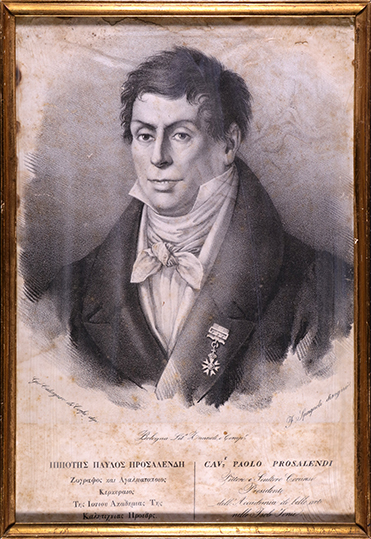
F. Spagnoli after Giovanni Calosguro (act: Bologna). The Knight Paolo Prossalendi, Painter and Statue Maker, c. 1840. Copperplate engraving on paper, 35 x 24. Courtesy of the Corfu Reading Society, Corfu. | Vrokinis records that Giovanni Calosguro “in indication of his gratitude towards his first instructor, aside of a bust of marble that he had long been creating, having designed his image, after sending it to Bologna in order to be lithographed, distributed its copies in his homeland and the rest of the Ionian islands. This image was accompanied by another ‘Ethical image’, written by him in Italian and included in the then published ‘Album Ionio’.” (Vrokinis 1877:140). Consequently, F. Spagnioli represented the bust of Prossalendi with a necktie above a shirt and the insignia of the Order of St Michael and St George on the lapel of his coat.
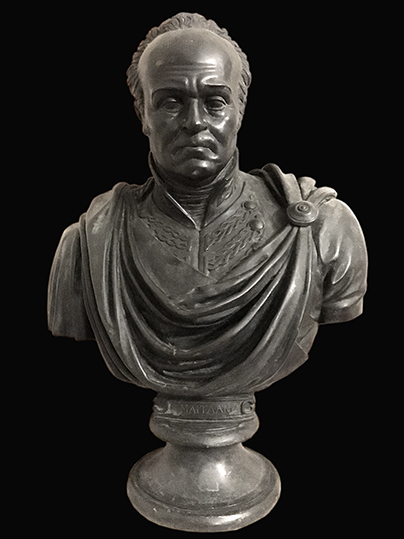
Paolo Prossalendi (Corfu, 1784-1837). Bust of Sir Thomas Maitland, 1821-1822. Bronze. Courtesy of the Palace of St Michael and St George, Corfu. | Sir Thomas Maitland (1760-1824) was a Governor of Malta, and served as Lord High Commissioner of the Ionian Islands during 1815-1823, with a seat of administration at Corfu. Popularly known as “King Tom”, he was a sound administrator. He established government banks, built roads and lighthouses. Mindful of the importance that the Ionians attached to titled people, he instituted the Order of St Michael and St George, whose honours were to be bestowed on suitable recipients in the Ionian Islands and Malta. To equip the new Order with headquarters as well as to house the Senate and provide a home for the Lord High Commissioner, he commissioned the Palace that still graces the lower Esplanade, Corfu Town. When he died and was buried in Malta in 1824, he was mourned in Corfu with special requiem ceremonies. His bust, made by Prossalendi, is the first in Greece to be cast in bronze. Interestingly, an 1817 plaster study of this bust, housed in The Thorvaldsen Museum, Copenhagen, suggests that Prossalendi had sought the advice of his fellow sculptor Bertel Thorvaldsen (1797-1838) for the casting.
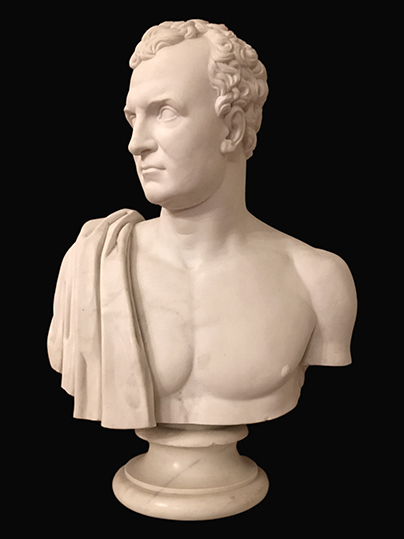
Paolo Prossalendi (Corfu, 1784-1837). Bust of Sir Frederick Adam, 1825. Marble. Courtesy of the Palace of St Michael and St George, Corfu. | General Sir Frederick Adam (1784-1853) was a Scottish major-general at the Battle of Waterloo. Between 1824 and 1832 he was Lord High Commissioner of the Ionian Islands. He married the Corfiot Diamantina Palatianou and for her sake he built the Palace of Mon Repos. In the Bust of Adam Prossalendi emphasises the purely idealistic elements, the heroic expression and the imperial style in a faithful rendition of the classicist ideals. On the pedestal, he presents four reliefs in an order: on the front side Ares, on the right side Agraeos Nómios, on the left side Athena and on the back the personification of Corfu. These are symbolic figures, in order to highlight the virtues of the subject, his military status, his contribution to the island’s agriculture, his wisdom and his love of the island.
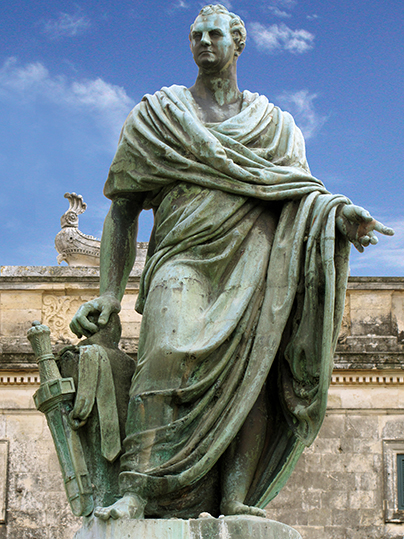
Paolo Prossalendi (Corfu, 1784-1837). Statue of Sir Frederick Adam, 1832. Bronze. Courtesy of the Palace of St Michael and St George, Corfu. | Sir Frederick Adam was a popular Lord High Commissioner of the Ionian Islands in Corfu. He benefited the island by building roads and constructing an aqueduct to bring fresh water from Benitses to Corfu Town. In 1832, Paolo Prossalendi created the Statue of Adam, a monumental work in bronze, to honour him because under his commission “the waters were imported from Benitses to Corfu Town” (Vrokinis 1877:227-236). The work was placed on a cylindrical pedestal, in the middle of a water tank, where the public fountain had been located, in front of the Palace of St Michael and St George at the northern end of the Esplanade.
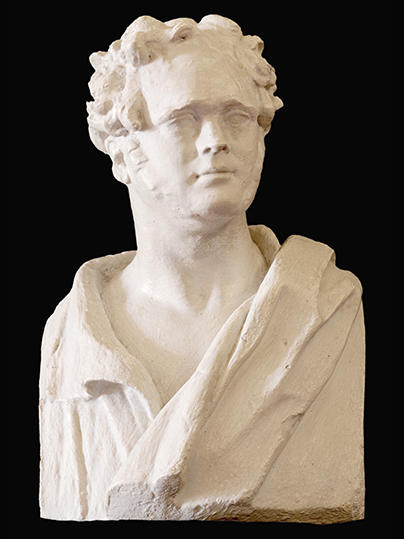
Paolo Prossalendi (Corfu, 1784-1837). Bust Portrait of Lord Nugent, c. 1835. Plaster, 29 x 19 x 16. Courtesy of the Corfu Reading Society, Corfu. | George Nugent-Grenville (Buckinghamshire, 1789-1850), 2nd Baron Nugent of Carlanstown, was an Irish politician. He was educated at Brasenose College, Oxford, and in 1810 received the honorary degree of D.C.L. from the university. He was Whig Member of Parliament for Buckingham, 1810-1812. In November 1830 Nugent was made one of the Lords of the Treasury, but he resigned this position in August 1832, tobecome Lord High Commissioner of the Ionian Islands. This office he retained for three years, from 1 December 1832 to 23 February 1835, returning to England with the Grand Cross of St. Michael and St. George. He was a member of the Reform Club and the Athenaeum Club. Nugent died on 26 November 1850, at his residence in Buckinghamshire. Prossalendi’s present plaster Bust Portrait of Lord Nugentis a small preliminary model for the larger fine bronze in the Palace of St Michael and St George, Corfu. As so many of Prossalendi’s works have been lost or destroyed, it is wonderful that this work was preserved by Alice Padova-Anderson (1936-2011) and subsequently bequeathed to the Corfu Reading Society.
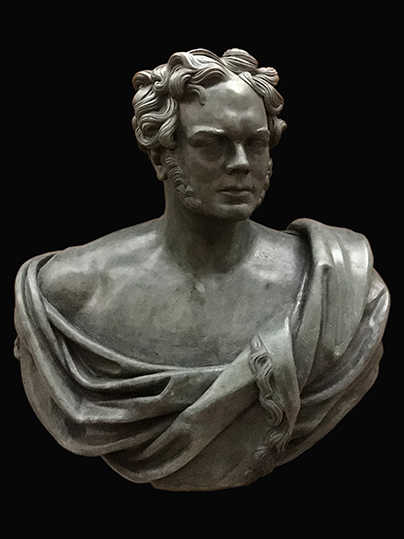
Paolo Prossalendi (Corfu, 1784-1837). Bust of Lord Nugent, 1835. Bronze. Courtesy of the Palace of St Michael and St George, Corfu. | In August 1832, George Nugent-Grenville, 2nd Baron Nugent of Carlanstown, became the 3rdLord High Commissioner of the Ionian Islands. This office he retained for three years, returning to England with the Grand Cross of St Michael and St George. The Bust of Nugentwas made around the time when the next Commissioner, Sir Howard Douglas (1776-1861), replaced him, in 1835. The Commissioner is rendered with his head turned slightly to the left, so that he can see beyond the viewer. The idealistic expression of the face, faithfully based on classicist ideals, stylistically matches the elements of the toga that marks the bust’s boundaries. It is noteworthy that no source refers to Prossalendi as the creator of the official bronze version (Christou 2001:48). However, the emergence of its small preliminary model of plaster at the Corfu Reading Society confirms the fact that it is the work of the Greek sculptor.
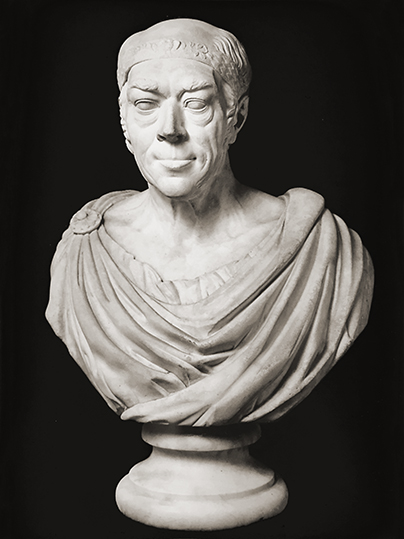
Giovanni Calosguro (Corfu, 1794-1878). Bust of Frederick Guilford, 1827. Marble, 90 x 63 x 61. Courtesy of the National Gallery – Alexandros Soutzos Museum, Athens. | Giovanni Calosguro belongs, along with Paolo Prossalendi the Elder and Dimitrios Trivolis-Pieris, among the Ionian island artists who revived the art of sculpture there, creating the first works of modern Greek sculpture. The bust of the great Hellenist and Philhellene Frederick North, Earl of Guilford (1776-1827), who in 1824 founded the Ionian Academy on Corfu and with whose financial assistance a number of Greeks studied abroad, was made in the year of his death, 1827, initially by Prossalendi, on commission from the society of the professors of the Ionian Academy. Calosguro then made a similar bust on his own initiative, more than life-size, which was nearly an exact copy of the one by Prossalendi. When the latter was requested in Athens, it was replaced by the bust of Calosguro. But its base, with its inscription composed by the distinguished scholar and colleague of Guilford Christophoros Filitas, stayed at the Ionian Academy and on it was placed Prossalendi’s work, which was destroyed by the bombing of 1943. The sitter is depicted wearing the specially designed ancient-style uniform of the Lord of the Ionian Academy, fastened on his right shoulder by a brooch. His mature age is expressed by the wrinkled cheeks and the stringy but at the same time rather loose neck while his gaze is fixed, in keeping with the neoclassicist model, his eyebrows heavy and lips fleshy, with a slight smile. The thin hair on his head is framed in relief by a decorative band with an owl in the centre, the symbol of education. The imposing rendering of the figure expresses self-confidence and satisfaction and stresses the Earl’s dynamic personality. (Tonia Giannoudaki. National Glyptotheque – Permanent Collection. Athens, GR: National Gallery – Alexandros Soutzos Museum, 2006, p.30).
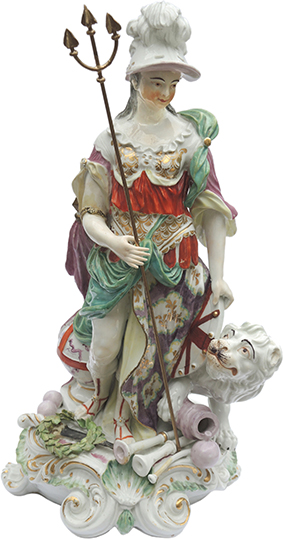
Attributed: William Duesbury (England 1725-1786). Derby Figurine of Britannia, c. 1765. Porcelain, 37 x 19 x 14. Courtesy of Megakles Rogakos Collection, London. | This 1760s Derby porcelain Figurine of Britannia, standing on a raised scroll moulded base, was probably made by William Duesbury. Being the largest version of its kind, it is a very imposing and elegant piece. The female figure is dressed in warrior outfit supporting with her left hand the shield next to the British Lion to one side, while standing by the globe partially protected by her flag to the other side. The elaborate baroque base reveals some implements of war and peace, including a cannon with balls, a pair of trumpets and a laurel wreath over a sword. The figure is nicely modeled and lovingly decorated with colour and gilt. The the composition is stunning down to the detail on the globe, the snake armband and all the faces – Britannia’s, the Lion’s and even the tiny Medusa’s on her bosom. The Medusa as a buckle for the aegis, a magical shielding shawl, decisively links Britannia to Athena.
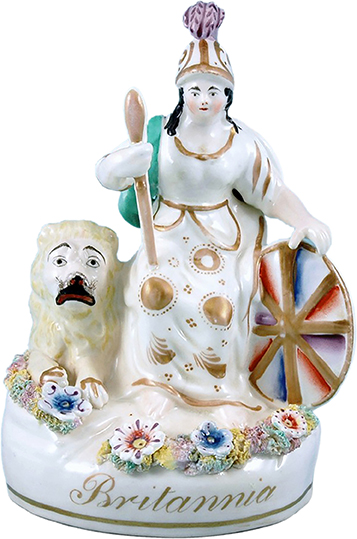
Attributed: John and Rebecca Lloyd of Shelton (England, act: 1834-1852). Staffordshire Figurine of Britannia, c. 1840. Porcelain, 16 x 11 x 11. Courtesy of Megakles Rogakos Collection, London. | This 1840s Staffordshire porcelain Figurine of Britannia, seated on the British Lion, while holding the shield and the sceptre with either hand, is rather unusual. The model for Britannia is somewhat plump, and this fact is perhaps further highlighted by her thick helmet topped by bold purple plumes. The craftsmanship is attributed to John and Rebecca Lloyd of Shelton. Typical of Staffordshire potters, who often copied successful porcelains, a touch of humour is revealed on the sombre subject – the whimsical smile on the face of Britannia and the rather dopey expression given to the British Lion. As a classical figure in the north, Britannia has thrown a jacket over her one shoulder and back. The Union Jack pattern on her shield makes it appear like coloured candy and becomes the palette for the bed of flowers shared by herself and her pet. Gilt is used to accentuate extra decorative details all over the composition and for the title at the front of the base.
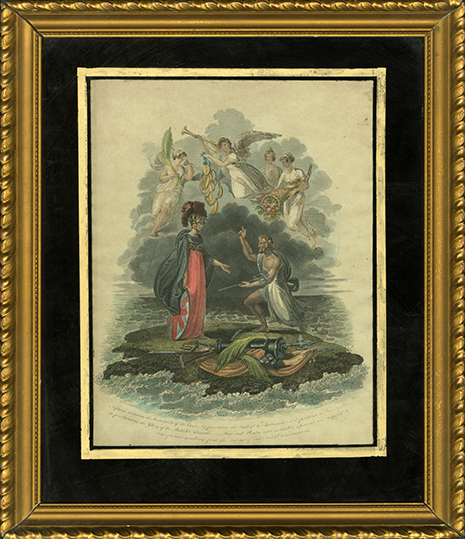
John Thurston (England, 1774-1822). Britannia receiving Neptune’s Trident, 1807. Hand-coloured copperplate engraving on paper, 26 x 20. Courtesy of Megakles Rogakos Collection, London. | John Thurston, who exhibited at the Royal Academy from 1794 to 1812, is memorable for his skills as a copperplate engraver for book illustrations. He developed the unusual technique of drawing straight onto the copper sheet. Here, he represents Poseidon emerging from the sea onto the British soil in order to meet glorious Britannia, at whose feet rest the materials of war and peace, and offer her his trident. Thurston’s print is inscribed: “Neptune (Poseidon) resigning the sovereignty of the Ocean, by presenting his Trident to Britannia : and pointing to Fame who / is proclaiming the Glory of the British Admirals. Peace and Plenty emblematically represent the happy / consequences resulting from the valour of our Naval Commanders.” This trident is an almighty weapon fully empowering its holder. Therefore, Poseidon’s gesture of handing his trident to Britannia is a gesture of utmost trust, respect and courtesy. The idea is that armed with such weapon, Britannia becomes the ever invincible ruler of the seas.
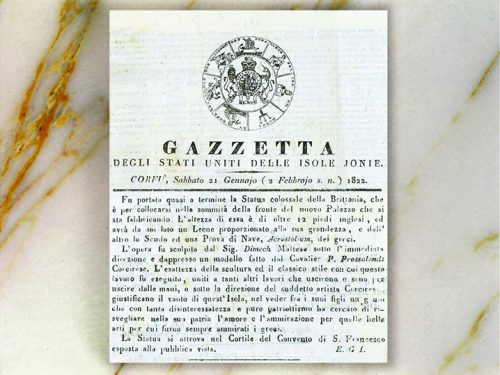
Gazzetta degli Stati Uniti delle Isole Jonie, #214, 21 January 1822, p.2. Courtesy of General State Archives – Archives of the Prefecture of Corfu. | Thanks to Mrs Nella Pantazi, Director of the General State Archives – Archives of the Prefecture of Corfu, here is reproduced the first announcement of the Statue of Britannia in the Gazette of the United States of the Ionian Islands. The original Italian text is translated as follows:
“The colossal statue of Britannia, which is to be placed on the top of the front of the new building that is being built, is almost completed. The height of it is over 12 English feet, and on the one side it has a Lion proportional to its size, and on the other the Shield and a Prow of Boat, Acrostolium, according to the Greeks. § The work was sculpted by Mr Dimech from Malta under the immediate direction and enlarged from a model made by Cavalier P. Prossalendi from Corfu. The exactness of the sculpture and the classical style with which this work is performed, combined with many other works that have come out of the hands, or under the direction of the aforementioned Corfiot artist, justify the pride of this island, a child prodigy who with so much disinterestedness and pure patriotism has tried to awaken in his homeland the love and admiration for those fine arts for which the friars always adored the Greeks. § The statue is found at the courtyard of the Convent of St Francis exposed to the public view. E.C.I.
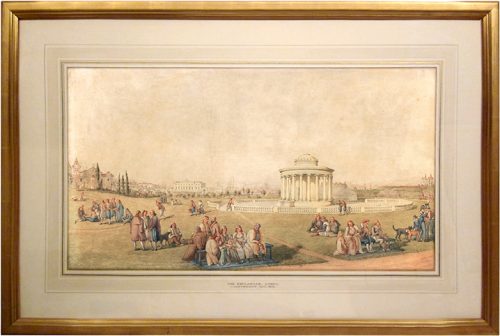
Joseph Cartwright (England, 1789-1829). The Esplanade, Corfu, c. 1825. Ink and watercolour on paper, 30 x 55. Courtesy of Spiro Flamburiari Collection, London. | In this watercolour, Joseph Cartwright represents the whole stretch of Corfu’s Esplanade from the Maitland Memorial (1816) in the south to the Palace of St Michael and St George (1819-1823) in the north, both buildings designed in the Regency style by the British architect Sir George Whitmore (1775-1862). The Maitland Memorial, located in the Upper Esplanade (south), was constructed in 1816 as a peristyle rotunda with 20 columns in the Ionic order. It was dedicated to the British Lord High Commissioner of the Ionian Islands Sir Thomas Maitland (1760-1824), and exudes the general climate of classicism that prevailed at the time. This Memorial is also known as Sterna(water tank) because when it was built, it covered the older Venetian Gradenigo Water Tank. The two entrances of the Memorial were intended to serve those who continued to use the tank after its construction. In this scene’s foreground are groups of people, men and women, largely Corfiots but also Jews and a few British people, in a variety of local and European costumes.
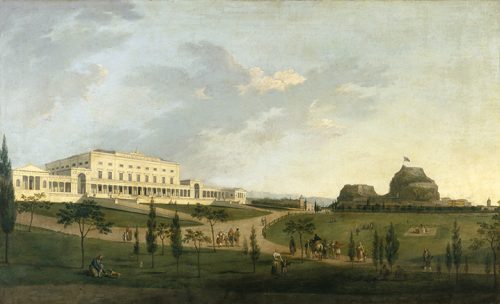
Joseph Schranz (Germany, 1803-1853). The Palace of St Michael and St George, Corfu, c. 1830. Oil on canvas, 59 x 95. Courtesy of the British Embassy, Athens. | In this painting Joseph Schranz juxtaposes the Old Fortress of Corfu, built on the rocky peninsula with the two distinctive peaks, and the newly built Palace of St Michael and St George in the northern part of the Esplanade. He takes the opportunity to reproduces with considerable accuracy the palace that Sir George Whitmore KCH (1775-1862) was commissioned to design and construct between 1814 and 1824. The imposing and large-scale building complex of the palace was built with an architectural morphology that essentially introduced English romantic classicism to the Ionian Islands. The building is the largest palace in Greece, after the palace of Otto in Athens, today’s Parliament. It is distinguished by majesty and elegance despite its large size. It is a three-storey building, joined through the outer Doric peristyle and two arches, to two side wings. The parapet of the palace’s superstructure is adorned with reliefs with the symbols of the Ionian Islands, designed by the important Corfiot sculptor Paolo Prossalendi. Crowning the façade there was a statue representing Britannia with the British Lion and the Phaeacian Galley, also by Prossalendi, which the British took when they left the island in 1864. This is the earliest record of the palace’s façade, whose statue of Britannia has since become a legend.
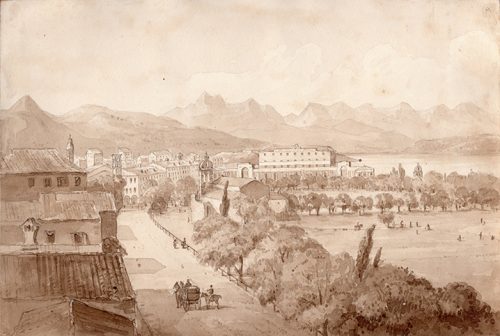
James Horsbrugh (Britain, 1820-1868). View of the Esplanade with St Nicholas of the Jewess and the Palace of St Michael and St George from the Port Raymond Barracks, c. 1840. Graphite and sepia on paper, 17 x 28. Courtesy of Private Collection, London. | James Horsbrugh was a British artist who joined the 10thLincolnshire regiment in 1838, when it served extensively in the Eastern Mediterranean. This sketch presents a rare and studied view of the Esplanade, the central square of Corfu, as a patchwork of Venetian, French and British influences. The Esplanade stretches over an area of 84,000 m², between the Old Fortress and the Old Town, making it the largest square in the Balkans. Its name comes from the Italian spianare, which means to flatten, and this was because it was created in the 16th-17thcentury when the Venetians decided to demolish the buildings that were located around the fortress in order to improve its view of the sea and also increase the firing range for the defenders. The formation of the site began in 1537 when the Venetian architect Michele Sanmicheli (1484-1559) set some boundaries in the area and banned the rebuilding, while in 1628 the boundaries were extended and the demolition of many additional buildings was imposed. In addition contemporary building were built amphitheatrically in the area that remained, between the two Corfu Fortresses, and the alleys leading to the square were formed at right angles to it for defensive reasons as well. Between 1807 and 1814, the French built the imposing buildings in the Liston, forming the centre of the social life of Corfu and the most cosmopolitan meeting point. The church of St Nicholas of the Jewess, built before 1600 and demolished by the British in 1842 (Spyridon K. Papageorgiou, History of the Church of Corfu, Corfu, 1920, p.198), dominates the forefront of this view. During the British protectorate period, between 1818 and 1824, the construction of the Palace of St Michael and St George, on the northern side of the Esplanade, was designed to be used as the residence and administrative centre of the British Lord High Commissioner. Here, the palace has already been completed and adorned with the sculptural composition of Prossalendi’s Britanniaon the front façade’s superstructure. In the background the Pantocrator (Almighty), the highest mountain in Corfu, at an altitude of 906 metres, is dominant.
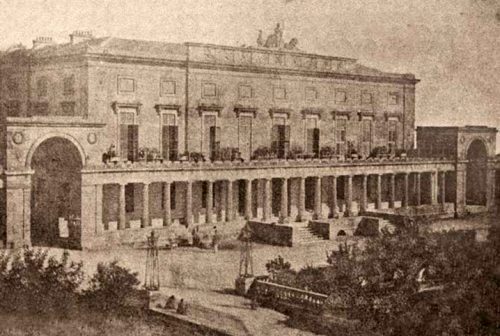
Augusto Colla (Italy, 1821-1888). View of the Palace of St Michael and St George, Corfu, 1857. Albumen print on paper. Courtesy of the Michael Kokkalis Archive, Corfu. | Augusto Colla photographed the façade of the Palace of St Michael and St George in 1857, when the Britanniasculptured ensemble, based on design by Paolo Prossalendi and executed by Vincenzo Dimech (1768-1831), was still in situ. The creation of the work and its placement is described by Lavrentios Vrokinis (1850-1911), principal representative of Corfiot historiography – “In 1822, upon instruction and supervision by Prossalendi based on preliminary model by himself, the Maltese sculptor Dimech, who happened to be in Corfu, created out of tuff the colossal statue of Britannia of a height of twelve English feet, having relative to its size analogies, on the one hand the Lion and on the other the Shield and the Prow of the Boat (Acrostolionaccording to the ancients), which previously appeared in general view at the forecourt of the then school of fine art, and was then appended on the top of the façade of the then founded Palace at Corfu’s main square (now Union Square).” (Vrokinis 1877:230-231). A brief description of the work is also available in the Gazzetta degli Stati Uniti delle Isole Jonie, #214, 1 January 1822, p.2.
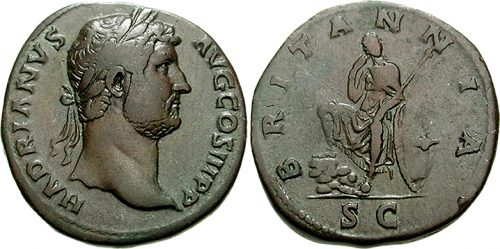
Sestertius of Hadrian (AD 117-138). Britannia Seated with Spear and Shield, c. AD 120. Bronze. Courtesy of Classical Numismatic Group, London. | There were many coin types, also medals, issued under Hadrian (AD 76-138), commemorating his travels throughout the Roman Empire, visiting various provinces to take stock of his inheritance and calm the disquiet, which had arisen in the later years of Trajan’s reign. This impressive and rare sestertius was struck in commemoration of the first of these, sometime around AD 120, when Hadrian crossed the Channel to Britannia where, during his stay, construction began on a seventy-three-mile long wall across the north of the province, known to this day as Hadrian’s Wall. Here, Britannia is seated slightly left, with head facing and resting on her right arm, spear lying on her other arm, right foot set on rocks, and round shield to her right. Similar coin types were also issued under Antoninus Pius (138-161), who carried out some repair work to Hadrian’s wall. As Roman influence in Britain declined, Britannia was not seen again on coins until 1672, during the reign of Charles II (1630-1685). The present bronze coin was the actual model for Britannia used for the copper farthing in 1672.
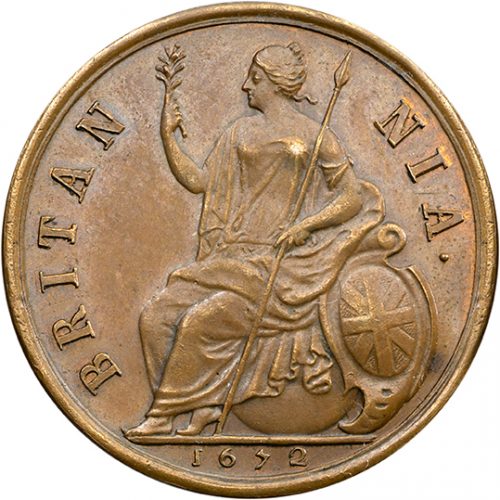
Farthing of Charles II (1630-1685). Britannia Seated on a Globe, 1672, London. Copper. | On copper halfpennies and farthings issued under Charles II (1630-1685) in 1672, Britannia made her re-appearance since Roman times. She is shown seated on a globe, facing left, with an olive branch in her right hand, a spear in her left hand, and a shield leaning against the globe. The shield bears the pattern of the Union Jack from the British flag. The design and attributes of this portrayal of Britannia are almost certainly inspired by the earlier Britannias who appeared on the Roman coins. The model for this Britannia was supposedly Frances Teresa Stuart (1647-1702), a great beauty of the Restoration period who refused to become the mistress of Charles II. She eventually married the Duke of Richmond and Lennox.
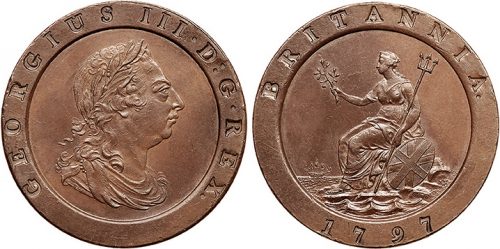
Cartwheel Penny of George III (1760-1820). Portrait of George III / Britannia seated on a Mount, 1797. Copper, 4. Courtesy of Milly Flamburiari Collection, London. | The George III 1797 Cartwheel Penny had a most innovative design. It was inordinately large and thick, in order to fit requirements of its time for intrinsic value, as part of an attempt to restore confidence in British currency. The seated and armed figure of Britannia echoes the previous versions. With her right hand she is holding out an olive branch. This is the first time, however, in which her stereotypical spear turns into a trident. The goddess is seated on rock emerging from a piece of land that is surrounded by waves, and a sailboat appears on the horizon in the background. Poseidon’s trident submitted to her hands and the marine setting indicate the Royal Navy’s peak of efficiency during the French Revolutionary Wars (1793–1801) and foretell the eventual fact that Britannia was to “rule the waves” and strike a decisive victory in the Napoleonic Wars (1803–1814 and 1815).
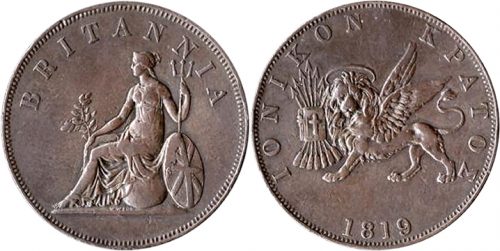
Obol of George III (1760-1820). Britannia seated on a Globe / Winged Lion holding Gospel, 1819. Copper, 3.Courtesy of Private Collection, London. | The obolwas issued under George III (1760-1820), King of United Kingdom of Great Britain and Ireland, in 1819 as the currency of the United States of the Ionian Islands during the British Protectorate between 1814 and 1864. The obverse shows Britannia developing from the previous versions, seated left on a globe, resting her right hand on an olive tree and her left on a trident, with the union shield to the right. The reverse shows the Winged Lion of St Mark standing left, head facing frontally, wearing a halo, and holding the Gospel that radiates seven arrows, emblematising the Heptanese– Corfu, Cythera, Cephallenia, Ithaca, Lefkas, Paxoi and Zante.
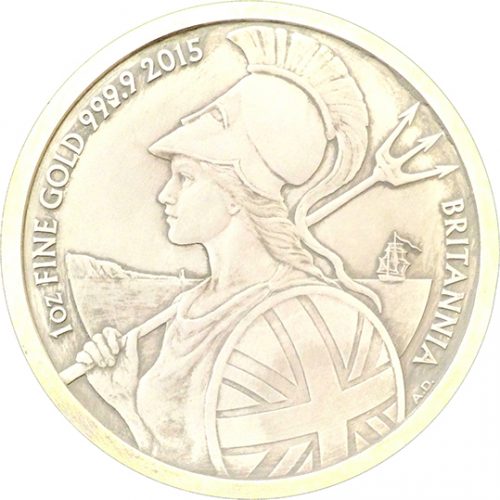
Antony Dufort (Ireland, b. 1948). Britannia: Two Pounds Commemorative Coin, 2015. Plaster, ∅:20 x 2. Courtesy of The Royal Mint, Wales. | In 2015, The Royal Mint commissioned Antony Dufort to issue a new definitive £2 coin, bearing an image of Britannia. What is new about his design is the head and shoulders close-up of Britannia, which gives the viewer the opportunity to engage more with the character of the goddess. The sculptor admitted that he based his design on an ancient Greek statercoin in his personal collection, presenting the helmeted head of Athena, wearing a chiton, and armed with weapons of war. Dufort’s Britannia, partially based on his wife’s countenance, is presented in profile with long hair covered by a Corinthian helmet with long plume. She is supporting her trident with one hand over her one shoulder. The other shoulder is protected by her round shield that bears on it the Union Jack pattern. On the left side of the background appear the White Cliffs of Dover, facing France, a geophysical barrier emblematic as a shield against aggression from the continent. On the other side appears a ship on the high seas standing for Britain’s dominance over the sea. In the £2 coin the cliffs and the ship were omitted, but they are present in the gold sovereign based on this design.
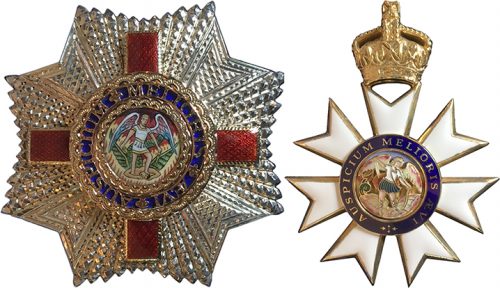
Order of Saint Michael and Saint George, 2012. Courtesy of Sir Efthimios E. Mitropoulos, London. | The Most Distinguished Order of Saint Michael and Saint George is a British order of chivalry founded on 28 April 1818 by George, Prince Regent, later King George IV, while he was acting as regent for his father, King George III. Named in honour of two military saints, the Order was originally awarded to those holding commands or high position in the Mediterranean territories acquired in the Napoleonic Wars, and was subsequently extended to holders of similar office or position in other territories of the British Empire. It now recognises service in a foreign country, or in relation to foreign and Commonwealth affairs, for example the work of foreign-service officers and diplomats. The original home of the Order was the Palace of St Michael and St George in Corfu, the residence of the Lord High Commissioner of the Ionian Islands and the seat of the Ionian Senate. Since 1906, the Order’s chapel has been in St Paul’s Cathedral in London.
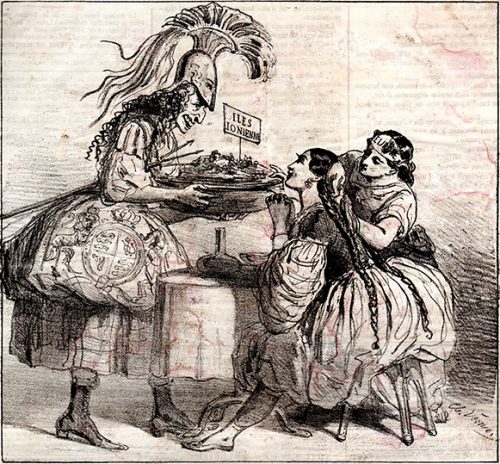
Charles Vernier (France, 1813-1892). Le Charivari – News 159: A Good Joke (Actualités 159: Une bonne plaisanterie), 01.01.1863. Courtesy of Private Collection, London.| Europe is alerting a handsome maiden, to whom Great Britain is offering a platter, with these words: “A pretty present that is about nothing… it must be a dish of her business… there is of course something underneath… beware, my little one, beware!” (Un si joli present que cela à propos de rien… ça doit être un plat de son metier… il y a bien sûr quelque chose la-dessous… méfiez vous, ma petite, méfiez vous!)
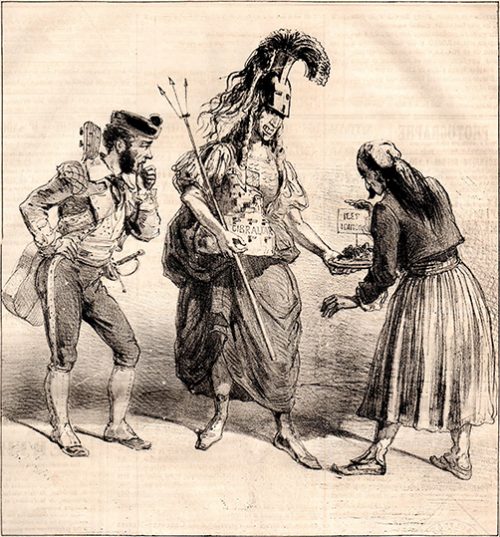
Charles Vernier (France, 1813-1892). Le Charivari – News 161: The New Year Gifts (Actualités 161: Les étrennes), 13.01.1863. Courtesy of Private Collection, London. | While having a firm grip over Gibraltar, Britannia is offering a platter labelled “Ionian Islands” to the Evzone. The Spaniard, who is at the other end, thinks to himself: “Of course she will give me my Christmas tip too.” (Bien sur quelle va me donner aussi mes étrennes.)
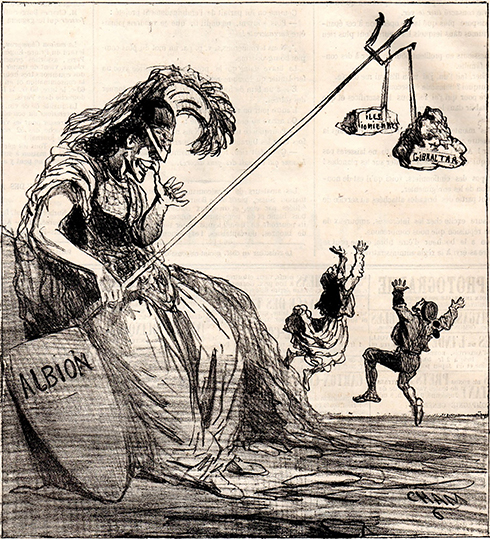
Cham (France, 1819-1879). Le Charivari – News 172: Very Good! (Actualités 172: Les étrennes), 19.01.1863. Courtesy of Private Collection, London. | Britannia, identified as Albion, is resting on a rock and lifting the Ionian Islands and Gibraltar from her trident, as attractions away from the reach of an eager boy and girl. Thumbing her nose at the children, she says to them: “Very good, my friends, you are getting there, have more courage, you are nearly touching them!” (Très bon ! mes amis ! vous y êtes ! un peu de courage ! vous touchez presque !)
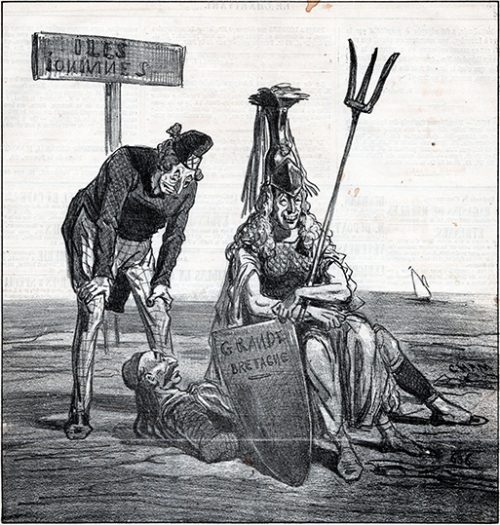
Cham (France, 1819-1879). Le Charivari – News 592: A Good Joke (Actualités 592: Une bonne plaisanterie), c. 1865. Courtesy of Private Collection, London. | A signpost suggests that the location of this incident is the Ionian Islands, and the caricature is inscribed “A Good Joke” (Une bonne plaisanterie). The British statesman of the Liberal Party William Ewart Gladstone (1809-1898) bends over the Evzone, and says to him: “My dear Greek!… keep quiet and continue to lie under Great Britain!…” (Mon cher Grec ! …tenez-vous tranquille et continuez de vous reposer sur la Grande Bretagne ! …).
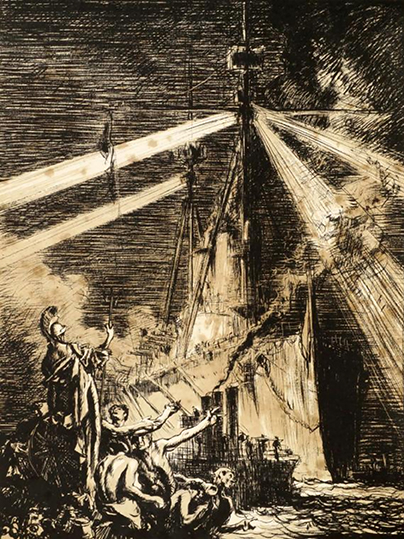
Sir Frank Brangwyn (Belgium, 1867-1956). Launching a Battle Cruiser, c. 1915. Duotone lithograph on paper, 64 x 50. Courtesy of Robert A. Christoforides, London. | During the First World War, Sir Frank Brangwyn designed a great number of posters, which he sold as prints to raise money for the war effort. His bold, vigorous and extrovert art was suited to the expansive spirit of late-Victorian British society. Aiming to protect the British Empire’s sea-lanes, Admiral John Fisher, the Royal Navy’s First Sea Lord, masterminded the battle cruiser, a large and modern warship that made its appearance in 1908. “HMS Incomparable” was the name given by Fisher to a proposal for a very large such warship that was suggested in 1915. Despite research into the concept, it never came close to being built, largely owing to impossible costs. This print is a fantasy portrayal of the launching of an enormous battle cruiser that dwarfs the three-funnel ship before it. Ashore a group of shipyard workers proudly introduce the fruit of their labour to Britannia. The picture’s drama is accentuated by the light rays that beam from the couple of immense masts down and around the otherwise dark scene. Such works were propaganda for the national effort against any threat to the country and the empire at large.
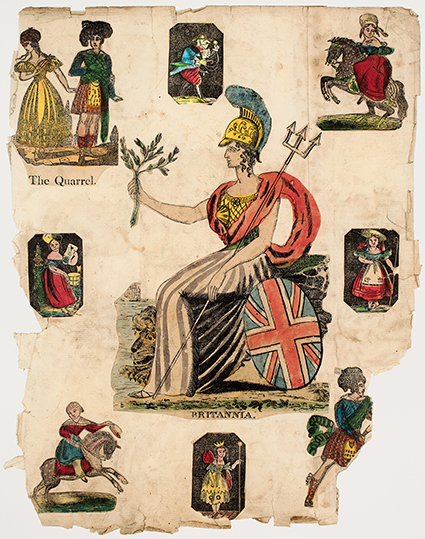
Sir Peter Blake (England, b. 1932). Found Art: Britannia, 2011. Digital print with silkscreen glaze, 122 x 102. Courtesy of Ferdy Carabott Collection, London. | Peter Blake’s Found Artseries is based upon one of the most original tenets of pop art – that everyday objects can become the subject matter for fine art. The artist focuses upon common objects to which people are indifferent because they consider them valueless. His studio is famed for being close to a museum of popular culture objects and printed ephemera. He wants us to see these objects in a new way – as art. An interest in ‘outsider’ art has always been integral to his work. The magnification at which he submits these objects allows us to appreciate the beauty of their design, their fragility and their textural quality. Here, Blake brings to our attention what looks like a page from an 18thcentury document like a diary, with a composition of collaged cut-outs of contemporary hand-coloured engravings. Central amongst the cut-outs is Britannia. In the periphery around her are various other subjects serving to fill the space of the page, a playing card on all four sides and a pair of equestrian figures and the before-and-after of a lover relationship in the corners. This Found Artis an intriguing piece with the quality of an early naïve North American curiosity, here probably concerned with Britannia as a ‘hangover’ from British imperialism. Interestingly, the branch that Britannia holds out is clearly from an olive, evocative of Athena’s connection to this tree. Enlarged to a monumental degree, this relic image, comparable to the classical ruins, is a permanent reminder of the vanity of things.
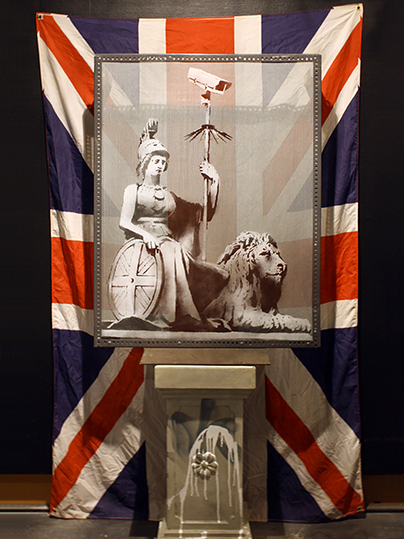
Banksy (England, b. 1974). One Nation Under CCTV, 2009. Mixed media installation. | In 2009 it was documented that 4.2 million closed-circuit television cameras operated in Britain, making this nation the most watched society in the world. Effective CCTV schemes are an invaluable source of crime detection and evidence for the police (in 2009 Scotland Yard used CCTV footage as evidence for 95% of murder cases). Still, concerns remain about surveillance systems’ potential to violate personal privacy. The graffiti artist Banksy, whose work touches on political issues, showed One Nation Under CCTVat the “Banksy Versus Bristol Museum Summer Show”, held at the Bristol City Museum & Gallery, 13 June – 31 August 2009. Here, in a sarcastic spirit he criticises the use of CCTV cameras and pulls off a rather daring protest. Against the British flag and atop a classical pedestal, soiled by graffiti and splashed paint, he props up a custom-made picture of Britannia seated next to Landseer’s Lion. Here the trident’s finial is replaced by a CCTV camera guarded underneath by a ring of spikes.
Public Information
“Prossalendi’s Britannia” – Historical Perspective
Curated by Megakles Rogakos
Opening: 8pm, Saturday, 7 July 2018
Duration: 7 – 29 July 2018
Venue: Ionian Academy, 1 Kapodistriou & Akadimias Street, 49100 Corfu, Greece
www.ionio.gr/en/prospective/university-history
Opening Hours: 8.30am – 9pm daily, except Sunday
Communication: Mrs Dionysia Karvouni, +30 26610 87129, int_rel@ionio.gr
Visuals:vwww.corfuheritagefoundation.org/prossalendis-britannia-historic/
Reservation: Eventbrite
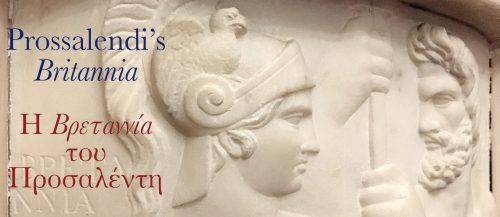
2 thoughts on “Historical Perspective”